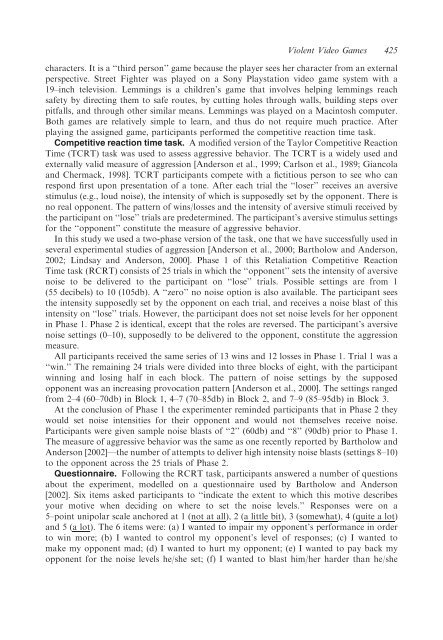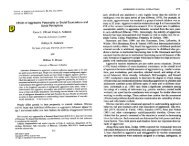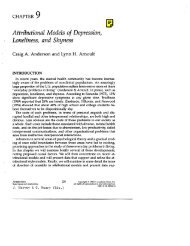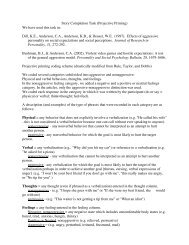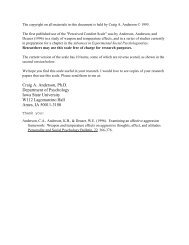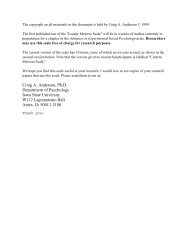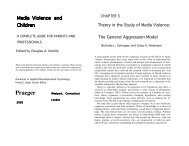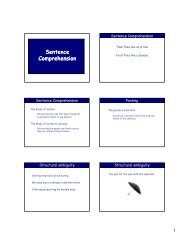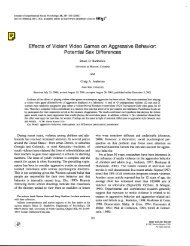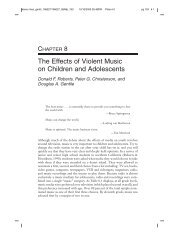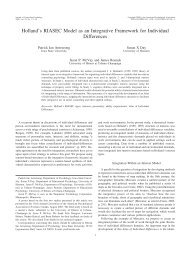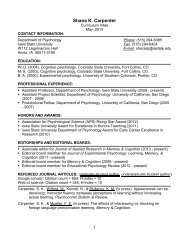Violent Video Games and Aggressive Behavior in Young Women
Violent Video Games and Aggressive Behavior in Young Women
Violent Video Games and Aggressive Behavior in Young Women
You also want an ePaper? Increase the reach of your titles
YUMPU automatically turns print PDFs into web optimized ePapers that Google loves.
<strong>Violent</strong> <strong>Video</strong> <strong>Games</strong> 425<br />
characters. It is a ‘‘third person’’ game because the player sees her character from an external<br />
perspective. Street Fighter was played on a Sony Playstation video game system with a<br />
19–<strong>in</strong>ch television. Lemm<strong>in</strong>gs is a children’s game that <strong>in</strong>volves help<strong>in</strong>g lemm<strong>in</strong>gs reach<br />
safety by direct<strong>in</strong>g them to safe routes, by cutt<strong>in</strong>g holes through walls, build<strong>in</strong>g steps over<br />
pitfalls, <strong>and</strong> through other similar means. Lemm<strong>in</strong>gs was played on a Mac<strong>in</strong>tosh computer.<br />
Both games are relatively simple to learn, <strong>and</strong> thus do not require much practice. After<br />
play<strong>in</strong>g the assigned game, participants performed the competitive reaction time task.<br />
Competitive reaction time task. A modified version of the Taylor Competitive Reaction<br />
Time (TCRT) task was used to assess aggressive behavior. The TCRT is a widely used <strong>and</strong><br />
externally valid measure of aggression [Anderson et al., 1999; Carlson et al., 1989; Giancola<br />
<strong>and</strong> Chermack, 1998]. TCRT participants compete with a fictitious person to see who can<br />
respond first upon presentation of a tone. After each trial the ‘‘loser’’ receives an aversive<br />
stimulus (e.g., loud noise), the <strong>in</strong>tensity of which is supposedly set by the opponent. There is<br />
no real opponent. The pattern of w<strong>in</strong>s/losses <strong>and</strong> the <strong>in</strong>tensity of aversive stimuli received by<br />
the participant on ‘‘lose’’ trials are predeterm<strong>in</strong>ed. The participant’s aversive stimulus sett<strong>in</strong>gs<br />
for the ‘‘opponent’’ constitute the measure of aggressive behavior.<br />
In this study we used a two-phase version of the task, one that we have successfully used <strong>in</strong><br />
several experimental studies of aggression [Anderson et al., 2000; Bartholow <strong>and</strong> Anderson,<br />
2002; L<strong>in</strong>dsay <strong>and</strong> Anderson, 2000]. Phase 1 of this Retaliation Competitive Reaction<br />
Time task (RCRT) consists of 25 trials <strong>in</strong> which the ‘‘opponent’’ sets the <strong>in</strong>tensity of aversive<br />
noise to be delivered to the participant on ‘‘lose’’ trials. Possible sett<strong>in</strong>gs are from 1<br />
(55 decibels) to 10 (105db). A ‘‘zero’’ no noise option is also available. The participant sees<br />
the <strong>in</strong>tensity supposedly set by the opponent on each trial, <strong>and</strong> receives a noise blast of this<br />
<strong>in</strong>tensity on ‘‘lose’’ trials. However, the participant does not set noise levels for her opponent<br />
<strong>in</strong> Phase 1. Phase 2 is identical, except that the roles are reversed. The participant’s aversive<br />
noise sett<strong>in</strong>gs (0–10), supposedly to be delivered to the opponent, constitute the aggression<br />
measure.<br />
All participants received the same series of 13 w<strong>in</strong>s <strong>and</strong> 12 losses <strong>in</strong> Phase 1. Trial 1 was a<br />
‘‘w<strong>in</strong>.’’ The rema<strong>in</strong><strong>in</strong>g 24 trials were divided <strong>in</strong>to three blocks of eight, with the participant<br />
w<strong>in</strong>n<strong>in</strong>g <strong>and</strong> los<strong>in</strong>g half <strong>in</strong> each block. The pattern of noise sett<strong>in</strong>gs by the supposed<br />
opponent was an <strong>in</strong>creas<strong>in</strong>g provocation pattern [Anderson et al., 2000]. The sett<strong>in</strong>gs ranged<br />
from 2–4 (60–70db) <strong>in</strong> Block 1, 4–7 (70–85db) <strong>in</strong> Block 2, <strong>and</strong> 7–9 (85–95db) <strong>in</strong> Block 3.<br />
At the conclusion of Phase 1 the experimenter rem<strong>in</strong>ded participants that <strong>in</strong> Phase 2 they<br />
would set noise <strong>in</strong>tensities for their opponent <strong>and</strong> would not themselves receive noise.<br />
Participants were given sample noise blasts of ‘‘2’’ (60db) <strong>and</strong> ‘‘8’’ (90db) prior to Phase 1.<br />
The measure of aggressive behavior was the same as one recently reported by Bartholow <strong>and</strong><br />
Anderson [2002]—the number of attempts to deliver high <strong>in</strong>tensity noise blasts (sett<strong>in</strong>gs 8–10)<br />
to the opponent across the 25 trials of Phase 2.<br />
Questionnaire. Follow<strong>in</strong>g the RCRT task, participants answered a number of questions<br />
about the experiment, modelled on a questionnaire used by Bartholow <strong>and</strong> Anderson<br />
[2002]. Six items asked participants to ‘‘<strong>in</strong>dicate the extent to which this motive describes<br />
your motive when decid<strong>in</strong>g on where to set the noise levels.’’ Responses were on a<br />
5–po<strong>in</strong>t unipolar scale anchored at 1 (not at all), 2 (a little bit), 3 (somewhat), 4 (quite a lot)<br />
<strong>and</strong> 5 (a lot). The 6 items were: (a) I wanted to impair my opponent’s performance <strong>in</strong> order<br />
to w<strong>in</strong> more; (b) I wanted to control my opponent’s level of responses; (c) I wanted to<br />
make my opponent mad; (d) I wanted to hurt my opponent; (e) I wanted to pay back my<br />
opponent for the noise levels he/she set; (f) I wanted to blast him/her harder than he/she


